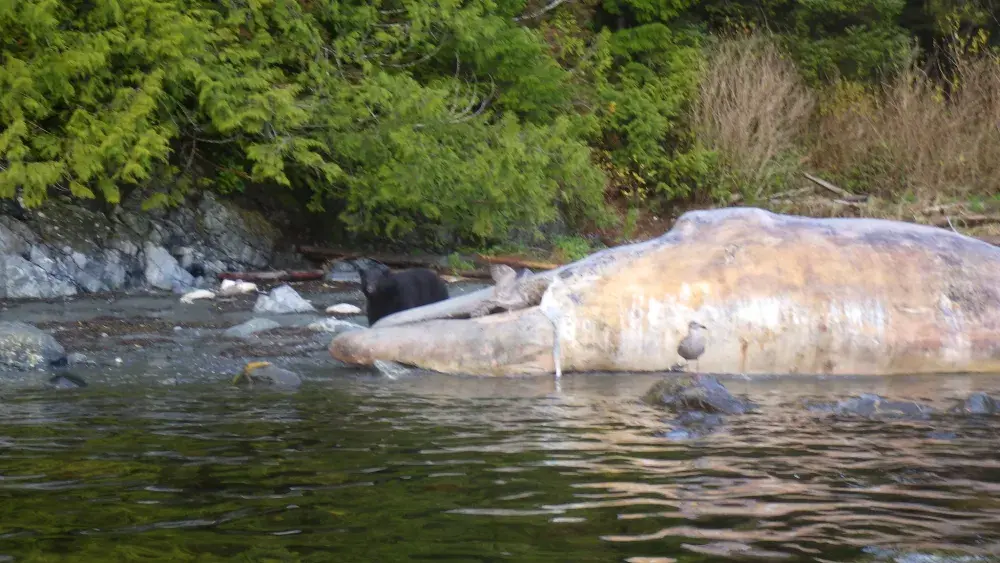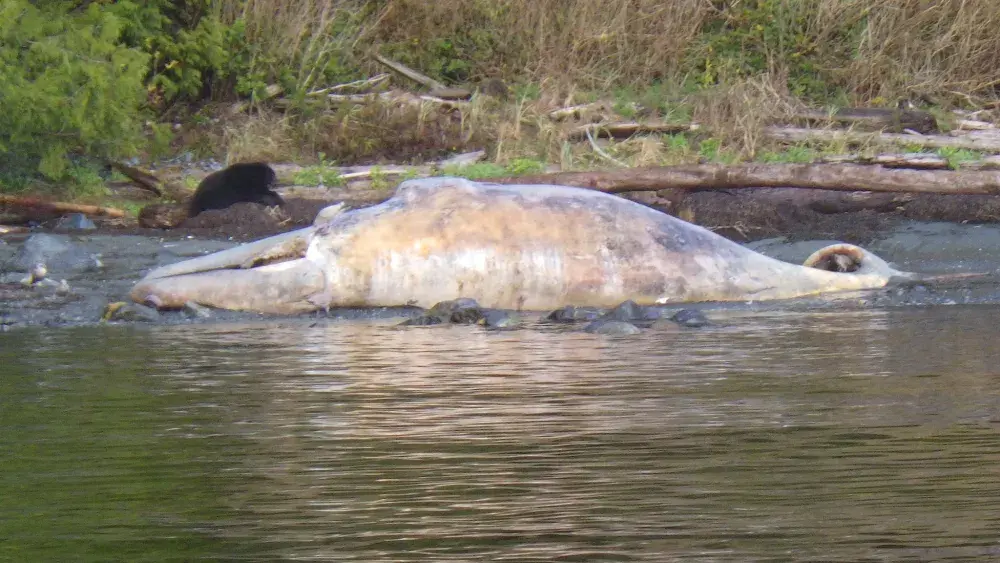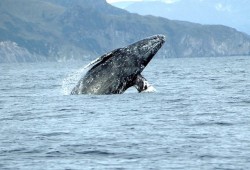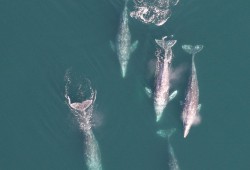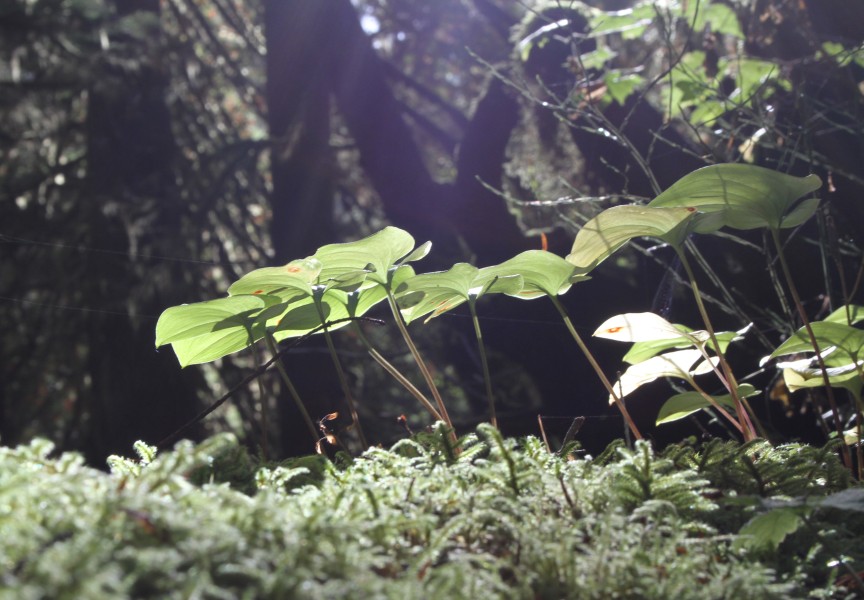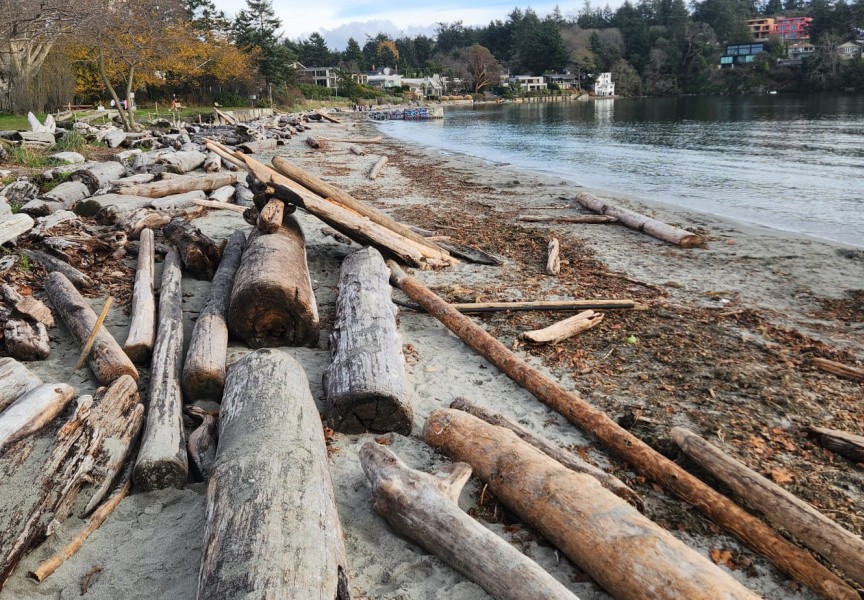Karen and Stephen Charleson, who have lived at Hesquiaht Harbour for decades, encountered a sight early this month they’ve never seen before: two bears feasting on what appeared to be the carcass of a grey whale.
Stephen had first spotted the massive carcass floating the area about a month prior. Then on Dec. 1 he noticed the bears eating it.
“It looks like a gray whale to me,” wrote Stephen through a social media app sent to Ha-Shilth-Sa. “The smaller bear started eating inside the whale's jaw before we left the site. (We were in a canoe just off the beach watching). I haven't seen any bears eating a whale before. I first spotted the carcass about a month ago across the way from us.”
Before heavy rains began, Stephen noticed the bears were at the carcass again on Sunday, Dec. 3.
“We have looked through binoculars once in a while to see if the bears are still there--yesterday they were still there,” Stephen wrote. “It is too rainy today to see if the bears are there, but we could see the carcass early this morning before the rain started. It is about two miles across the harbour from where we live.”
Hesquiaht Harour is approximately 45 kilometres northwest of Tofino, accessible only by boat or float plane. The Charlesons have lived there for a least part of the year since the mid-1990s, running the Hooksum Outdoor School, and built a house about 15 years ago to reside in Stephen’s traditional territory at Ayyi’saqh year-round.
They usually don’t see many grey whales, unless Hesquiaht gets a good herring spawn, like they had in February and March for the past two years.
“If it has been a good spawn here, they stay in the harbour and feed for two, three, or more weeks before continuing their migration south,” wrote Karen. “If there is not much herring spawn, we might not see many gray whales at all (less than 10), but in the last few years there have been slowly improving herring spawns (since the gillnet fishery has been shut down), and there have been more whales feeding in the harbour (sometimes up to 60 at a time).”
The recovery of the grey whale is considered “a conservation success story” by the USA’s National Oceanic and Atmospheric Administration. The species that migrates along the West Coast of North America was near extinction in the 1940s, but since hunting the mammal was banned grey whales returned to what is believed to be pre-commercial-whaling numbers.
But since the population peaked at 27,000 in 2016, an unusually high number of carcasses have been washing up on the shores, like what recently appeared at Hesquiaht Harbour. As of last winter, the NOAA estimates that the population of grey whales on the eastern side of the Pacific has dropped to approximately 14,500. This due to a remarkable die off that began in January 2019, which researchers call an Unusual Mortality Event.
“Most of the animals that are washing up are very underweight,” said Erin Gless of the Pacific Whale Watch Association. “They’ve done necropsies on them and there doesn’t appear to be a virus or anything like that.”
Each year grey whales migrate along the North American coast, from their summer feeding grounds in the Arctic to the warm waters of Mexico’s Baja, where they give birth in the winter months. A recent study from Oregon State University has found that changing ocean conditions in the Arctic could be limiting the available food that the population of recent years was able to support.
“Climate change is affecting a wide range of global systems, with polar ecosystems experiencing the most rapid change,” stated the study, which was led by assistant professor Joshua Stewart.
The study ties the volume of seafloor crustaceans that grey whales eat to the declining amount of ice floating on the ocean. The bottoms of these frozen platforms hold algae which feeds the biomass below.
“We found that the population dynamics of an iconic and highly mobile polar-associated species are tightly coupled to Arctic prey availability and access to feeding areas,” explained the study. “This suggests that even mobile, long-lived species are sensitive to dynamic and changing conditions as the Arctic warms.”
Stewart and his team identified another Unusual Mortality Events that began in 1999, a die-off that the grey whale population was able to recover from.
“We’re hoping that this is just another example of they go through these waves of up and down,” said Gless.
What’s bad for the grey whale population appears to be a benefit for bears and other animals that search for food along the coast.
“When these whales come to shore it’s actually a really great windfall for things like bears and wolves,” said Gless. “It’s bad for the whale, of course, but it’s a really important feeding opportunity for lots of species on the beach.”
“I think given the higher number of gray whale strandings all along their range including throughout British Columbia and including the Tofino area, it does not surprise me there would be instances of bears eating grey whale carcasses,” said John Calambokidis, a biologist at the Cascadia Research Collective, adding that at least 27 dead grey whales have been documented in B.C. waters in the last four years, while more deaths have likely gone unreported. “These would represent a potential source of food for bears, although many of the whales have been emaciated, which would reduce how rich a food source they would be with even the blubber of some of these whales having very low levels of lipids (fats).”
To help researchers gain a better understanding of the Pacific grey whale population, carcasses can be reported to Fisheries and Oceans Canada at 1-800-465-4336 or through email at DFO.ORR-ONS.MPO@dfo-mpo.gc.ca. DFO’s marine mammal coordinator planned to head to Hesquiaht Harbour in the first week of December to assess the remains of the animal.


